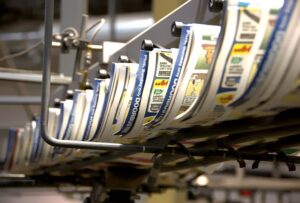Introduction:
Flexography, or flexo for short, is a popular printing process that uses a flexible printing plate to transfer ink onto a substrate. In this article, we will discuss the importance of flexo ink formulation in achieving optimal printing results.
What is Flexo Ink Formulation?
Flexo ink formulation refers to the process of creating ink that is specifically designed for use in flexographic printing. The formulation involves selecting the appropriate raw materials, such as resins, pigments, solvents, and additives, and blending them in precise proportions to achieve the desired properties for a particular printing application.
Importance of Flexo Ink Formulation:
The formulation of flexo ink is critical in achieving high-quality printing results. The ink must have the proper viscosity, tack, and drying characteristics to transfer smoothly and evenly onto the substrate. Additionally, the ink must be compatible with the printing plate, substrate, and press conditions to ensure that the final print meets the required specifications.
Factors Considered in Flexo Ink Formulation:
Several factors are considered when formulating flexo ink, including:
Substrate Type:
Different substrates require different ink formulations. For example, ink used for printing on a non-porous substrate like plastic will have different properties than ink used for printing on a porous substrate like paper.
Printing Conditions:
The printing conditions, including printing speed and temperature, affect the performance of the ink. Therefore, the ink must be formulated to suit the specific press conditions.
Color and Transparency:
Ink color and transparency are essential factors to consider when formulating ink. The right combination of pigments and solvents can achieve the desired color and transparency levels.
Adhesion and Durability:
The ink must have excellent adhesion to the substrate to prevent smudging or flaking. Durability is also a crucial factor, especially for applications that require the printed material to withstand harsh environments.
Formulation Process:
The formulation of flexo ink involves selecting the right raw materials, mixing them in specific proportions, and testing the ink for its suitability in the particular printing application. A thorough understanding of the factors mentioned above is crucial to creating an ink that performs optimally.
Sample Flexo Ink Formulation:
An example of a flexo ink formulation is as follows:
Ingredients:
Acrylic resin
Titanium dioxide pigment
Ethyl acetate solvent
Butyl acetate solvent
Ethanol solvent
Anti-skinning agent
Mixing Procedure:
Combine the acrylic resin, titanium dioxide pigment, and anti-skinning agent in a mixing vessel.
Mix the ingredients using a high-speed disperser until a smooth, uniform consistency is achieved.
Add the ethyl acetate, butyl acetate, and ethanol solvents slowly while mixing until the desired viscosity is reached.
Test the ink for suitability in the specific printing application.
This formulation is just an example and will require modification based on the specific printing job’s requirements. Ink manufacturers can tailor the formulation to meet the specific substrate, printing conditions, color, transparency, adhesion, and durability requirements of the job. It is important to work with a reputable ink manufacturer, such as IRANSHORAKA MFG, to achieve the best printing results.









